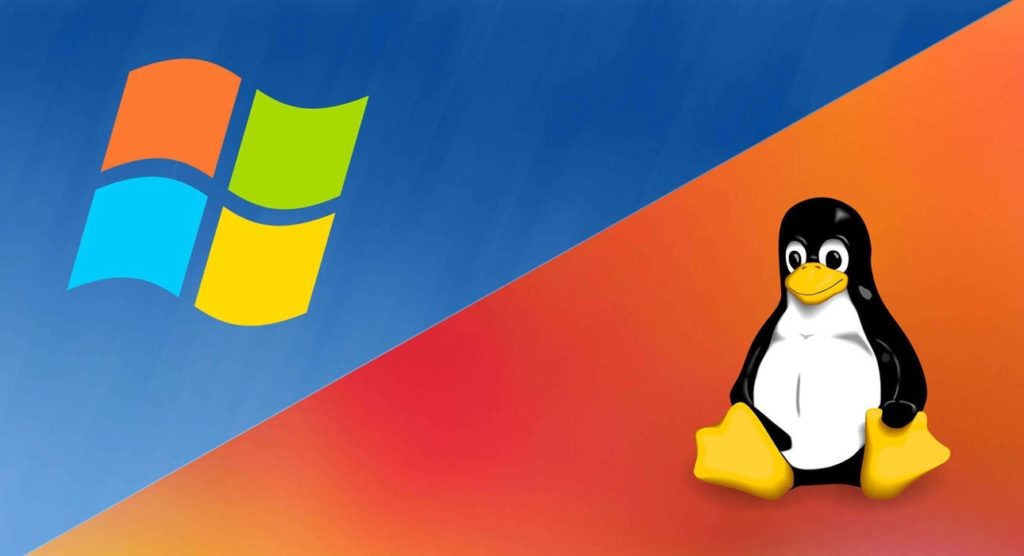
There are many operating systems available to us in the market, where the “Windows” operating system dominates the desktop computer market with a share of approximately 83% of the market, then “Mac OS” and “Linux” come second and third in order. But when it comes to the market for servers and large computers, Linux distributions dominate here.
Microsoft’s Windows operating system is a set of GUI-based operating systems that are programmed, developed and marketed by Microsoft. The Windows system mainly targets the personal computer market, and there are two versions of it; One of them is a 32-bit architecture, and the second is a 64-bit architecture. This branching extends to the domains of personal computers and servers as well. The first version of it came out to the public in 1985, and the last was in 2015 with the name “Windows 10”.
As for Linux; It is a group of free and open source “Unix-like” operating systems built on the Linux kernel. It is modified and built based on that kernel to come out in the form of different versions called “distribution” or “distro”, each of these versions is designed by a “distributor” to target a specific hardware market; There are distributors – we will get to know some of them later – that release distributions for tablets, PCs, or others. The first Linux operating system was released in 1991, and it is the most popular operating system for servers, and versions are available to run on personal computers as well.
The difference between Windows and Linux
The main differences between “Windows” and “Linux”
Linux is an open source operating system, while Windows is a closed source and commercial operating system.
Linux provides access to the “source code” and therefore has room for variation according to the needs of the user, while in Windows this feature is not available as only Microsoft is able to access it.
Linux runs faster on both modern and old hardware, while Windows gets slower if you’re using older hardware.
Linux distributors who develop and design Linux distributions do not collect information about users, while Windows collects information in the smallest details about its users, which threatens their privacy
It can be considered that Linux is more secure in that we can stop any program, command or connection via the x-kill tool, while it takes several attempts to stop it on Windows.
Linux outperforms Windows in the number of free software available, while Windows outperforms the number of game software.
The Linux operating system is almost free, with all programs, tools and complex applications (such as open office) free of charge, while Windows has a lot of free programs as well, but most of them are paid commercial.
Linux is considered more secure because vulnerabilities are easily identified and closed, while Windows has a larger user base, making it a popular target for malware and virus developers.
Linux is used by major companies to run servers and work systems for security, such as Google, Facebook, Twitter, etc. Windows is more popular with gamers and corporate offices.
Linux and Windows have the same support and functionality for external devices, hardware, tools, and accessories.
Reasons for moving from Windows to Linux
Microsoft has stopped supporting Windows 7, which means it has stopped getting security and technical updates. This left users wishing to operate a secure operating system with two options; Either upgrade to Windows 10 or move to a different location entirely.
If for whatever reason you’re uncomfortable with the direction Microsoft is taking with Windows 10 and are considering switching to Linux, this is the perfect timing.
Famous Forbes journalist Jason Evangelho talks about his experience with Linux in an article, and gives five main reasons why you might move from Windows to Linux:
Linux does not impose itself on you as Windows
Windows seeks with stubborn insistence to call your attention permanently, so you see “Cortana” inviting you to use it frequently, or messages inviting you to use the “Edge” browser whenever you open the “Chrome” browser or another trying to convince you of the advantage of Edge, and many other examples.
If you are looking for an operating system that does not get in your way every time you open a window or a program and gives you complete freedom of choice, then the “Ubuntu” version of Linux is the solution.
You won’t be at the mercy of the Terminal.
Through my research and personal experience, I have found that the effectiveness of Linux has greatly improved in the past 5-10 years. While the installation process was relatively easy, the post-installation setup was a nightmare. You had to spend your time with the Terminal to fix problems with the connected hardware, or to install graphics drivers and drivers. It required a lot of research and work.
As for my recent personal experience with version 18.04 of the Linux distribution “Ubuntu”, I did not find the need to use Terminal at all, and the system was able to identify most of the devices connected to the computer automatically.
Software installation just got easier
There is a prevalent reputation for complicating Linux in this regard, and this has been true in the past. I remember that I needed to download the program, then open the Terminal, then direct it to the installation location, then extract the files to the desired location and answer many privacy questions and permissions that you would grant it, and sometimes you needed to recompile the files that I extracted.